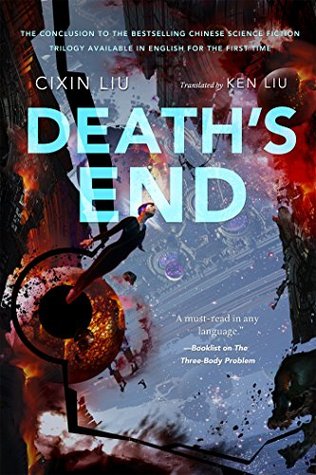Death's End, by Liu Cixin and translated by Ken Liu, is the third and final installment of the Remembrance of Earth's Past series. It chronicles the events following The Dark Forest and focuses on humanity's place in the universe. There is a lot of interesting science/science fiction concepts presented in this hard sci-fi novel, which keep you thinking on it for days on end.
Read on for my review, but bear in mind that as the third in the series there may be spoilers for The Three-Body Problem and The Dark Forest.
Overall Impression
This was an excellent book. Although it had a slow start and a lot of info dumping from time to time, it still shaped up to be an incredible story. The best parts of it are the concepts explored, a hallmark of hard science fiction stories. There's actually so many cool concepts introduced that I think a few of them deserved a story on their own. There are some decent characters and a good plot, but these pale in comparison to the sheer scope of the setting, which takes us across the universe in both space and time.
Plot
The story actually starts off in 1453, days before the fall of Constantinople at the hands of the Ottomans. This was a bit of a surprise for me as it didn't feel like it would connect with the rest of the story, but there is a key concept revealed at the end of that chapter that ties in to the events a millenium into the future. From then, it's a story of time hopping thanks to hibernation. The story of humanity is divided into eras: the Common Era, which corresponds to the present day; the Crisis Era, which involves the threat of Trisolaris; the Deterrence Era, where dark forest deterrence got instituted; and so forth. Thanks to hibernation our main character, Cheng Xin, is able to bring Common Era sensitivities to these distant time periods and we get to see the universe through her eyes.
Although the plot starts of a bit slow, it quickly ramps up as conflicts flare up again and the threat of dark forest strikes becomes imminent. My favorite part of Liu Cixin's books has been trying to untangle the secrets of the main plot. In The Three-Body Problem, it was figuring out how the mystery of the events surrounding the particle physicists and the Three-Body game. In The Dark Forest, it was figuring out the Luo Ji's Wallfacer plan. In this book, one of the main mysteries revolves around a set of three cryptic fairy tales.
Characters
While we see a couple of old characters, including Luo Ji, we mainly have a new cast centered on Cheng Xin, a scientist from the Common Era. We also have others like Yun Tianming, 艾 (Ai) AA, Thomas Wade, and Sophon. Overall, the characters can be a bit static and, in my opinion, serve only to ground the reader as they explore the universe. Thanks to hibernation, we get to see the same people over and over despite the large timespans involved. Having familiar faces/names, we can focus on what's truly important in this novel: the setting and concepts behind it.
Setting / World Building
This is truly where this novel, and the others in this series, shine. Prior books dealt with subatomic physics and sociology. Without spoiling too much, this book touches on spatial dimensions, the fabric of spacetime, and the speed of light. A cool aspect of Liu Cixin is how he blends real science with science fiction. This is, in the end, made up, but there is so much real science thrown in that it's difficult to see the line that divides the two. For example, string theory suggests there may be multiple hidden dimensions folded up inside each other and there have been some recent news reports on scientists effectively slowing down photons of light. One thing that may have been improved on was in the delivery of these concepts. Many of them are a result of info-dumping where the author just tells you what the important things are, only in a few occasions (the big ones, though) do we have the characters converse and try to figure out these things on their own.
In addition to all the cool concepts introduced, there's also the interaction between humans and other species. Chief among these is the Trisolarians. We left The Dark Forest at the dawn of the Deterrence Era, where humanity had figured out a way to stop the invasion fleet and ensure a truce between the two species. We continue to interact with the Trisolarians by way of their sophons and their droplet ships. There's a lot of interchange of technology and culture between the two species. There's also signs of other species in the universe as well. The universe is still a very dark place, though.
Final Thoughts
I thoroughly enjoyed this book as an excellent conclusion to the series. This feels like a book for scientists or people who enjoy science in general. The concepts introduced really make you think about the nature of the universe. The characters really take second place here; I'm sure people will continue to talk about this book for years to come, but when they do they won't necessarily remember the characters. I think I may prefer the second (The Dark Forest) as the best of the series, though.
A friend of mine had shared this video with me when I started reading the series. While I watched the video each time I finished the book, only now do I understand everything that is shown there (note: spoilers):

hi, I think this video is much better, it's considered as the best video about three body trilogy.
ReplyDeletehttps://www.youtube.com/watch?v=uopk_XFBAP0